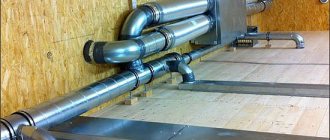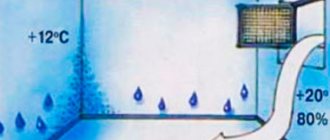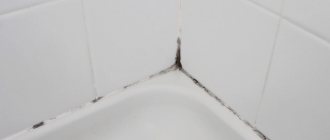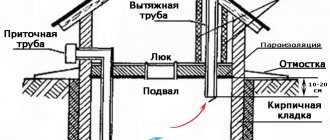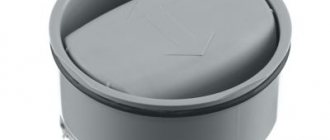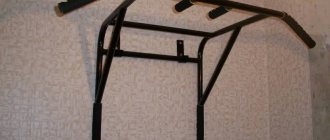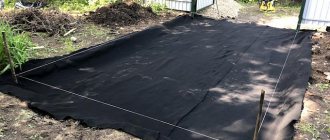High indoor air humidity is the main cause of mold development.
Molds spoil things and the environment, and also pose a danger to humans, as they increase the risk of allergies and respiratory pathologies.
A set of measures will help remove dampness, and preventive measures will help maintain the humidity level at normal levels.
For more information on how to remove humidity in an apartment, room or house, read the article.
Why does high humidity occur in the house?
Moisture inside a home appears in two ways: it penetrates from the outside or accumulates from the inside. The first case indicates mistakes were made during construction work, the second situation is typical for rooms with excessive condensation formation.
External causes of dampness in the house:
- the presence of unclosed gaps in the roof, through which precipitation (snow, rain) periodically penetrates into the home;
- gradual destruction of the foundation due to the lack of tide, as a result of which moisture accumulates under the floor covering;
- the formation of multiple cracks on the walls of the building;
- the use of a material (for example, plastic) for cladding a house that does not “breathe” and contributes to the accumulation of moisture inside the building;
- improper arrangement of supply and exhaust ventilation;
- close occurrence of groundwater in the absence of high-quality waterproofing from the outside and inside of the building.
Important! Dampness in a newly built wooden house often appears as a result of the use of poorly dried wood during construction.
There are several types of drywall, but for bathroom renovations only moisture-resistant material can be used Source zhk-akvapolis.rf
Where is the border between normal humidity and dampness?
Depending on the sources, recommendations on this matter may differ, but there is GOST for this case. In accordance with the state standard (GOST 30494-2011), which determines the microclimate parameters in residential premises, in winter humidity should be in the range from 30% to 45%, but not more than 60%, and in summer - in the range from 30% to 60% , but not more than 65%.
To be clear, we are talking about living rooms: bedrooms, living rooms and dining rooms. For toilets, kitchens and bathrooms, humidity is not standardized by GOST and can reach up to 100%. It is also worth noting that excessive dry air is no less harmful than dampness. During the heating season, you need to pay special attention to controlling the level of humidity: during this period, conditions are created in the apartment under which it can drop to critical values (15-20%). This humidity is typical for the Sahara Desert.
Air humidity is measured using a household device such as a hygrometer. It can be present as a function in many electronic devices - home weather stations, air washers, smart watches.
Why is dampness dangerous?
Excessive moisture inside a home has a negative impact on the health of permanent residents. Elderly people and young children suffer the most from fungus and mold. The most common consequences of prolonged exposure to a damp room are:
- development of dermatoses, mycoses;
- allergic reactions;
- the appearance of asthmatic attacks;
- frequent colds;
- headache;
- nausea;
- constant malaise;
- sleep disturbance;
- dizziness.
Attention! Increased moisture levels in the home often provoke exacerbation of chronic diseases in people. Therefore, it is extremely important to maintain an optimal humidity of 40-60% in the house.
Diseases from high humidity Source samstroy.com
Folk recipes
Salt and sugar are highly hygroscopic.
In addition to the methods listed above, there are also folk recipes that will help eliminate dampness in your home:
- If there is high humidity, you can place containers with salt, sugar, calcium chloride, charcoal or quicklime in the corners of the room. These substances are highly hygroscopic, therefore, they will quickly absorb excess moisture. Such containers need to be changed periodically.
- When humidity is high, bricks will help. It would seem, how to reduce humidity with bricks? Very simple, but only if there is a man in the house. The bricks must be heated and placed on a fireproof tray, near the moldy wall. This must be done until the dampness goes away forever. But it should be remembered that after the tenth heating, the bricks will no longer absorb moisture. Be sure to follow safety precautions when using this method. There should be no flammable things near the bricks.
- You need to clean a damp apartment using “drying” agents. This could be bleach, potassium permanganate solution or vinegar. After you have wiped all surfaces and floors, you should once again “walk” through these places with a dry cloth.
When using silica gel to reduce humidity, be careful if there are small children in the house.
- When high humidity in the apartment makes it difficult to live, use silica gel. This is the kind of product that can often be found in small packets in shoe boxes. They can be purchased in large quantities at pet stores, as they are used in cat litter. Spread this product around the apartment, you can also pour it under the bath. Only use silica gel if you do not have small children who might eat it.
- You can get rid of mold by using this solution. Dissolve salicylic acid in alcohol and dilute with water. Apply the solution to the pre-dried wall. This will help destroy the gray mold patches and dry out the air a little.
- Copper sulfate will also help fight mold. Gray traces must be scraped off and the wall treated with copper sulfate solution. It can be replaced with bleach, bleach, vinegar, soda or soap solution.
How to eliminate damp smell
The unpleasant smell of dampness often comes from furniture, things, walls, floors, and ceilings. You can remove it using special and folk remedies:
- Air ionizers and other preparations designed to eliminate unpleasant odors in rooms. They are sold in construction stores or department stores.
- Essential oils. They must be added to clean water, then rinsed off floors and other surfaces.
- Vinegar with water. It is recommended to mix these components in equal proportions and spray the resulting solution in areas with the most pronounced mold smell.
- Soda. Prepare an aqueous solution (1 tablespoon of soda powder per 200 ml of liquid), treat all places where the fungus is present.
- Hydrogen peroxide, bleaches. Apply directly to mold affected areas.
- Chlorine-containing products. Add to water, which is then used to wash floors, wall tiles, and other surfaces suitable for wet treatment.
- Ammonia. As part of an aqueous solution, it is generously applied to problem areas.
Important! The smell of dampness in an apartment or house indicates the presence of fungus in the home. To remove an unpleasant odor, its source must be destroyed.
Moisture-resistant plasterboard sheets are mounted close to each other; for additional protection from moisture, all joints and corners can be treated with sealant Source st5.stblizko.ru
Boil
All you need is a stove and a saucepan or kettle.
- Option 1. Bring water in a saucepan to a boil and place it on a table or windowsill so that the steam humidifies the apartment.
- Option 2: Boil the kettle and leave it on low heat for longer evaporation. This technique can be used when you are preparing food (the air often becomes dry at this time).
You can also add a few drops of tea tree or eucalyptus oil to the water. Their aroma is soothing, and the vapors kill germs and reduce the risk of colds and flu. In addition, you can throw cinnamon sticks, herbs or other spices into the water to make the air fragrant.
How to get rid of humidity at home
In a private building, it is much easier to eliminate excess moisture than in an apartment, where the appearance of mold is often caused by a violation of the construction technology of the entire building.
Laying waterproofing
Before dealing with dampness inside the building, you need to tackle the basement (if there is one). The use of concrete-containing dry mixtures will help normalize humidity. Using the latter, you need to plaster the area under the floor, seal all the cracks and crevices. For air outflow, it is necessary to install a hood with access to the street.
Then you need to move on to waterproofing the entire house. To do this, carefully plastering the external walls is performed. In a wooden building, the gaps between the logs are sealed with tow or glass wool.
It is important to pay special attention to the roof, even if there are no visible leaks. To prevent moisture from penetrating through the roof, its interior should be finished with any waterproofing material.
The next stage is the implementation of internal waterproofing of the building. Drywall is perfect for all rooms, but for the bathroom it is important to use a moisture-resistant type of such material or plastering.
If the neighbors above flood the plasterboard ceiling in the bathroom, it will have to be replaced: it will not be able to withstand such a load Source ogipse.ru
Redecorating
How to remove moisture in a house if it is not possible to carry out major repairs? In such cases, it is worth trying to perform surface repairs.
Procedure:
- Remove wallpaper damaged by dampness.
- Clean the surface from fungus, treat with an antiseptic (for example, copper sulfate).
- Wait a few days until the room dries out, or use a heater.
- Apply a layer of primer to the walls, and then plaster them or cover them with plasterboard.
- Finish the wall surfaces (hang wallpaper, paint).
It is advisable to replace the floor covering, even if it is not badly damaged, with a new one.
Arranging a plasterboard box is an excellent solution in cases where you need to hide risers or beds with a large diameter Source sovety-vannoy.ru
Dehumidifier: operating principles
We described in detail how to dehumidify the air in an apartment without a dehumidifier, but in some cases you cannot do without this device. A dehumidifier is used if the humidity in the apartment is too high, and other methods of combating it have not helped.
- Its operation is based on the absorption of air through the evaporator. The temperature inside the device is lower than in the room. Moisture condenses on its walls and flows into the container. In this case, the dried stream flows back into the room.
- So, this device will help you quickly dry out too humid air in your apartment. The desiccant can be portable or stationary. The latter have greater productivity. They are mounted on the wall, which saves room space. Portable ones have smaller dimensions, therefore their power is lower. When purchasing, you should clarify what the power of the device is. Choose a device with maximum power.
- You can try to assemble a dehumidifier yourself. To do this, watch the video after the article.
We have described in detail how to choose a dehumidifier for your home in this article.
How to reduce indoor humidity: preventive measures
Since it is not at all easy to remove dampness from the house, it is recommended to prevent excessive accumulation of moisture inside the home and follow these instructions:
- Ventilate the rooms periodically. It is possible to reduce the humidity in a room by regularly ventilating it. It is advisable for the kitchen window to be slightly open at all times, especially while preparing food. This is due to the fact that vapors emanating from boiling liquids condense on all surfaces, quickly absorb into the walls, and provoke the appearance of fungus.
- Eliminating sources of moisture. Often the main culprit for the spread of mold inside the house is wet laundry. If the premises are not equipped with a high-quality ventilation system, drying things in them is prohibited.
- Heating. In winter, heating devices should be turned on at the required power to keep the rooms warm and comfortable. Savings often lead to irreversible consequences: the growth of fungus on all surfaces, the appearance of mold even in cabinets.
Advice! In summer, windows should not be completely covered with curtains. Then the sun's rays will freely penetrate into the home, warm and dry it.
Before installing drywall in the bathroom, it is advisable to install a reliable metal frame Source guruotdelki.ru
Why is it worth drying out too humid air?
High humidity leads to the appearance of fungus in the house. Its spores are carried through the air, penetrating the lungs of the inhabitants and guests of the house. This causes rhinitis and asthma. If you live permanently in such unfavorable conditions, you are likely to suffer from chronic rhinitis, migraines, and disturbances in the functioning of the cardiovascular system. But there is no need to panic, in most cases you can successfully reduce the humidity.
The best drugs for dampness
There are many industrial products designed to combat high humidity in the home. Each of them has positive and negative sides and is used under specific circumstances. The most effective drugs are considered to be the following:
- Biocide. Eliminates fungus outside and inside the building and is characterized by significant effectiveness. Its main drawback is its high cost (800 rubles per 10 liters).
- Fongifluid. A ready-made solution that can be applied to almost all surfaces and coatings. Consumers note low product consumption and affordable price (550 rubles for 2 liters)
- Dali. A highly effective drug with a low cost (150 rubles per 0.6 l). It can be applied to all surfaces, including wallpaper and tiles.
It will be much easier to get rid of dampness in a private house or apartment if you initially accurately determine the source of its formation and spread. You can cope with this task yourself; in difficult situations, you should use the services of specialists.
When caring for plasterboard walls in the bathroom, it is not recommended to use acid-containing detergents Source krasimsami.com
Place containers of water around the apartment
You can do without boiling. Simply fill vases, bottles and other containers with water and place them near heat sources. If you add stones and flowers, you will get a beautiful composition - guests, most likely, will not even realize that these are not decorative elements, but homemade humidifiers. Just remember to periodically wash the containers and change the water.
furnitureteams.com
domo.plius.lt
mynohar.com
